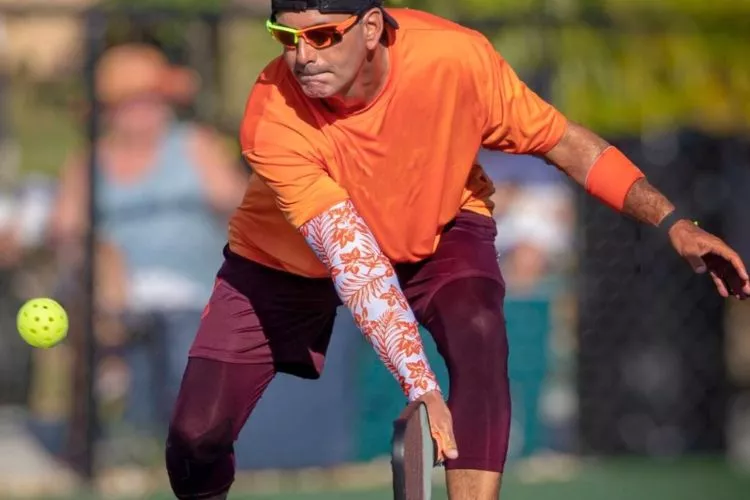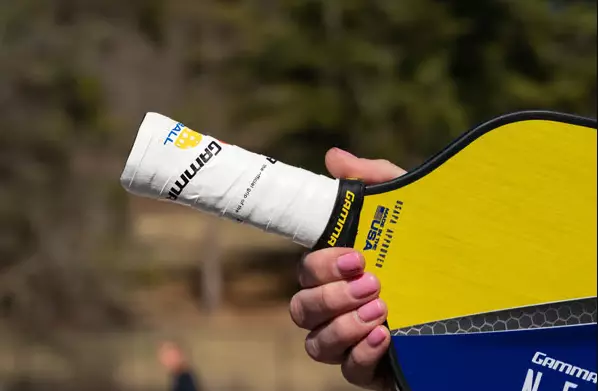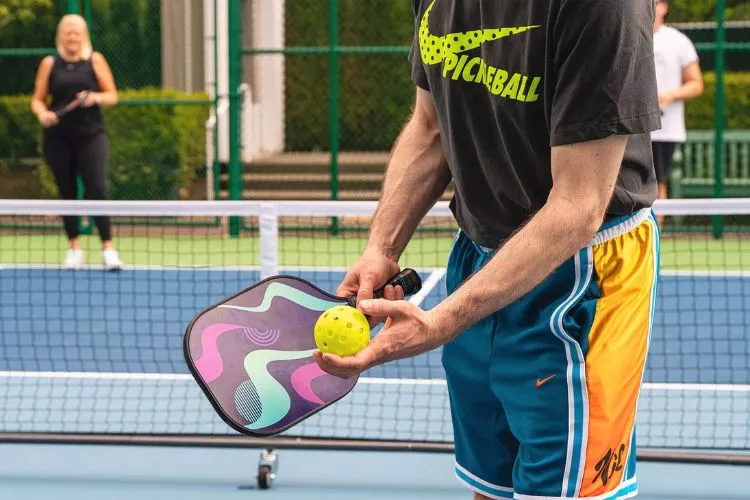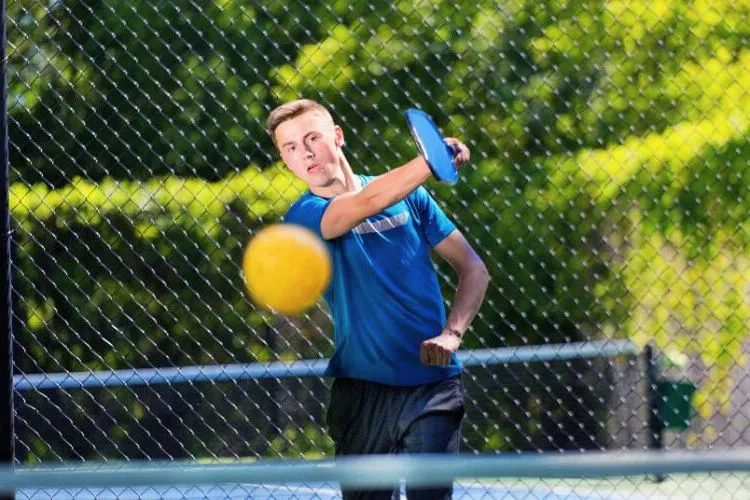Pickleball enthusiasts often seek ways to enhance their skills, and one vital aspect to elevate your game is learning how to drive the ball harder in pickleball with increased power.
This article delves into practical tips, smart techniques, and equipment advice tailored to boost your ball striking prowess on the court.
Unleash explosive drives and keep your opponents on their toes as you dominate the pickleball arena!

How to Drive the Ball Harder in Pickleball?
Driving the ball harder in pickleball is crucial for keeping the competition on their toes. Achieving this feat involves mastering key techniques like grip, stance, paddle speed, and more.
This guide provides comprehensive insights and practical tips designed to help you enhance your power shot, dominate the court, and intimidate your opponents.
Master the Grip
Your grip on the paddle sets the foundation for your swing. Optimum grip strength affords control over the paddle and, consequently, the ball’s direction and power. Adopt the “shake hands” grip.
This grip meshes the paddle with your hand, like a handshake, securing a robust hold and providing better control over your shots.

Shake Hands Grip: Reinforcing Power in Your Shots
The “shake hands” grip constitutes one of the most common ways to hold the pickleball paddle, equipping players with a strong and versatile stance. Just as its name suggests, it involves gripping the paddle as if you’re shaking someone’s hand, harmonizing your hand’s alignment with your paddle.
To get it right, start by extending your hand as if you’re about to greet someone with a handshake.
Once in position, place the paddle handle in your hand with the paddle face perpendicularly positioned to the ground. The handle should rest naturally in your palm’s center, and your fingers wrapped around it securely.
Your index finger’s base knuckle serves as a guide. It should align itself with the edge of the paddle, creating an angle similar to a handshake. If done correctly, you should clearly see your knuckles on top of the handle.
This grip offers several benefits that aid in delivering power-packed shots. First off, it secures a firm hold on the paddle, helping to mitigate the risk of paddle slippage during intense matches.
It ensures a reliable paddle face orientation, which empowers you with better control over your shots’ direction and intensity.
Moreover, the shake hands grip is versatile, which means it allows for both forehand and backhand shots without needing to change the grip. Consequently, you gain an edge in ready positioning, preparation time, and reaction speed when playing fast-paced games.
Most importantly, it distributes pressure evenly across your hand, reducing the chances of injuries due to excessive strain on specific hand parts.
The firm, yet slightly flexible grip the shake-hands technique offers help in executing power drives without unnecessary strain on the wrist or forearm.
To summarize, the shake hands grip is instrumental in playing powerful drives in pickleball, offering optimal stability, control, and versatility in your shots.
Perfect Your Stance
The right stance sets you up for a strong drive shot. Position your body in such a way that your knees are slightly bent, and feet set shoulder-width apart. This posture helps you stay on the balls of your feet, offering you the agility, balance and swift movement you need to go from serving to striking fiercely.
Contact the Ball Efficiently
Aiming the ball’s highest point for contact, ensures a solid and powerful hit. Ideally, the impact should occur right in front of your body, providing your ball the momentum it needs. Clean contact can help array the right amount of spin, helping your shot deliver the power punch it needs.

How do you hit a sweet spot on a pickleball paddle?
Hitting the sweet spot on a pickleball paddle can significantly enhance your shot’s power and accuracy. The ‘sweet spot’ refers to the center portion of the paddle’s face, where direct ball contact generates the most efficient energy transfer and minimal vibration.
It’s where you can hit the ball hardest while maintaining your control. Here’s how you can consistently hit it:
- Practice Familiarity with Your Paddle: Spend time with your chosen paddle. Get a feel for its weight, balance, and structure. Understand where the sweet spot is located; usually, it’s right in the center of the paddle.
- Grip and Stance: Adopt a comfortable and effective grip (like the “shake hand” grip) and maintain a balanced stance. An improper grip and stance could misalign the paddle and make it difficult to hit the sweet spot consistently.
- Swing Preparation: Plan your swings well in advance by predicting the ball’s trajectory and speed. This anticipation will allow you to position your paddle at the correct angle and height to hit the sweet spot.
- Watching the Ball: Keep your eye on the ball through its entire trajectory, from your opponent’s paddle to yours. Watching the ball closely will help you adjust your paddle to meet it at the sweet spot.
- Correct Contact Point: Aim to hit the ball slightly in front of your body and at a comfortable distance from you. This position allows better control over your swing, making it easier to hit the sweet spot.
- Regular Training and Drills: Practice consistently. Include drills that promote better ball-paddle contact, such as wall drills or partner drills. These exercises will improve your timing, control, and precision, equipping you to hit the sweet spot more consistently.
- Learning From Mistakes: When your shots are off, it’s likely you didn’t hit the sweet spot. Notice the difference in the ball’s speed, direction, and sound when you mess up. These details will help you correct your technique and improve.
Remember, it takes practice and patience to consistently hit the sweet spot on a pickleball paddle. It’s an essential skill that can drastically improve your game.
Body Rotation
The twist in your hips and torso is a cornerstone to launching powerful drive shots. This rotation, or the coiling-uncoiling action, generates power from the core. When you turn your body with the shot, it supports the shoulder and arm movement, enabling harder drives.
Follow Through Methodically
The act of hitting the ball isn’t over until you’ve followed through effectively. Every successful shot ends with the paddle’s head invading the space the ball occupied and your arm fully extended. Maintain your visual focus on the ball, and finish your swing in a smooth, continuous motion.
Maintain Paddle Speed
To impact ball speed, operate the paddle swiftly. Increase paddle speed before your paddlehead makes direct impact with the ball. The amplified speed of your paddle swing plays a crucial role in exerting additional power to your shot.
Effective Footwork
Good footwork is key to excellent pickleball playing. Being agile on your feet gives you a speed advantage and sets the groundwork for solid shots. A swift move towards the incoming ball sets you up for a prosperous backswing and a powerful strike.
Choose the Right Paddle
Your paddle is an extension of your hand. Choosing a paddle that suits your hand grip, body stature and playing style matters.
A paddle with a large sweet spot gives room for creating hard-hitting shots. Different paddles offer varying degrees of power and control attributes—you must choose one that aligns with your power drive priorities.
Consistent Practice
As the saying goes, “practice makes perfect.” Regular and dedicated practice works wonders in honing skills and improving game techniques. Focussed training involving power drive drills can help you reinforce your hard-hitting ability.
Power Drills
Incorporate drills to target your power game specifically. Implementing ball machine drills can arm you with a quick response mechanism and aid in driving the ball harder.
Wall drills are excellent for backhand and forehand practice, simultaneously improving your control over the ball and strengthening your power shot.
Power Drills for Pickleball
Drills can hone your power shots. One type of drill is the ball machine drill. Does that sound strange? Let’s talk more about it.

Ball Machine Drills
A ball machine hurls balls at you. These come fast. You must react quickly. This is where the power comes into play. The fast return needs strength. You push the ball back with force. Over time, your power shot improves.
The rapid-fire mode helps too. It mimics a real game. You face balls coming at different speeds. It trains your body and mind. You learn to adjust and hit hard.
Wall Drills
Then we have wall drills. These are simple and effective. All you need is a wall and a ball. You hit the ball against the wall. The ball comes back at you. You hit it again. Sounds easy, right?
With this, you practice two things. One is ball control. You learn how to hit the ball so it comes back to you. You try hitting it harder each time. This strengthens your power shot.
The wall drill is also good for backhand and forehand shots. You can switch between both. This adds variety to your drill. It also hones your skills.
Power Drills in Practice
Drills, overall, help you focus on power. You train by repetition. You focus on form and strength. With time, your shots get stronger. The ball machine drill makes you fast.
The wall drill helps control and power. Thus, specific drills make a better player out of you. When you get onto the court, it shows.
Conclusion:
Mastering the art of driving the ball harder in pickleball is no overnight feat. It takes consistent practice, perfecting your grip and stance, developing powerful forehand and backhand swings, and drilling until your precision becomes second nature.
By focusing on these elements while remaining receptive to learning from each game you play, you’re setting yourself up to become a formidable competitor on the court.
Combining strategy with power, a harder and more accurate drive is a true game-changer, potentially making you an unstoppable force in this fun and competitive paddle sport.

Pickleball’s more than a game to me—it’s a passion. I write, sharing its highs and lows, the thrills and the lessons. Some tales might draw you to the court, while others give a hint of the game’s magic. So, curious about my journey? Ready to dive deep into the world of pickleball with me? Let’s go.
